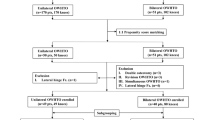Abstract
Obtaining a correct postoperative limb alignment is an important factor in achieving a successful clinical outcome after an opening-wedge high tibial osteotomy (OWHTO). To better predict some of the aspects that impact upon the clinical outcomes following this procedure, including postoperative correction loss and over correction, we examined the changes in the frontal plane of the lower limb in a cohort of patients who had undergone OWHTO using radiography. Forty-two knees from 33 patients (23 cases of osteoarthritis and 10 of osteonecrosis) underwent a valgus realignment OWHTO procedure and were radiographically assessed for changes that occurred pre- and post-surgery. The mean femorotibial angle (FTA) was found to be 182.1 ± 2.0° (12 ± 2.0 anatomical varus angulation) preoperatively and 169.6 ± 2.4° (10.4 ± 2.4 anatomical valgus angulation) postoperatively. These measurements thus revealed significant changes in the weight bearing line ratio (WBL), femoral axis angle (FA), tibial axis angle (TA), tibia plateau angle (TP), tibia vara angle (TV) and talar tilt angle (TT) following OWHTO. In contrast, no significant change was found in the weight bearing line angle (WBLA) after these treatments. To assess the relationship between the correction angle and these indexes, 42 knees were divided into the following three groups according to the postoperative FTA; a normal correction group (168° ≤ FTA ≤ 172°), an over-correction group (FTA < 168°), and an under-correction group (FTA > 172°). There were significant differences in the delta angle [DA; calculated as (pre FTA − post FTA) − (pre TV − post TV)] among each group of patients. Our results thus indicate a negative correlation between the DA and preoperative TA (R 2 = 0.148, p < 0.05). Hence, given that the correction errors in our patients appear to negatively correlate with the preoperative TA, postoperative malalignments are likely to be predictable prior to surgery.





Similar content being viewed by others
References
Bauer GC, Insall J, Koshino T (1969) Tibial osteotomy in gonarthrosis (osteo-arthritis of the knee). J Bone Joint Surg Am 51:1545–1563
Brouwer RW, Bierma-Zeinstra SM, van Koeveringe AJ et al (2005) Patellar height and the inclination of the tibial plateau after high tibial osteotomy. The open versus the closed-wedge technique. J Bone Joint Surg Br 87:1227–1232
Chae DJ, Shetty GM, Lee DB et al (2007) Tibial slope and patellar height after opening wedge high tibia osteotomy using autologous tricortical iliac bone graft. Knee 15:128–133
Coventry MB, Bowman PW (1982) Long-term results of upper tibial osteotomy for degenerative arthritis of the knee. Acta Orthop Belg 48:139–156
Coventry MB, Ilstrup DM, Wallrichs SL (1993) Proximal tibial osteotomy. A critical long-term study of eighty-seven cases. J Bone Joint Surg Am 75:196–201
Cullu E, Aydogdu S, Alparslan B et al (2005) Tibial slope changes following dome-type high tibial osteotomy. Knee Surg Sports Traumatol Arthrosc 13:38–43
Hunt MA, Fowler PJ, Birmingham TB et al (2006) Foot rotational effects on radiographic measures of lower limb alignment. Can J Surg 49:401–406
Jackson J (1958) Osteotomy for osteoartritis of the knee. J Bone Joint Surg Br 40:826
Kendoff D, Board TN, Citak M et al (2008) Navigated lower limb axis measurements: influence of mechanical weight-bearing simulation. J Orthop Res 26:553–561
Koshino T, Yoshida T, Ara Y et al (2004) Fifteen to twenty-eight years’ follow-up results of high tibial valgus osteotomy for osteoarthritic knee. Knee 11:439–444
Lobenhoffer P, Agneskirchner J, Zoch W (2004) open valgus alignment osteotomy of the proximal tibia with fixation by medial plate fixator. Orthopade 33:153–160
Marti CB, Gautier E, Wachtl SW et al (2004) Accuracy of frontal and sagittal plane correction in open-wedge high tibial osteotomy. Arthroscopy 20:366–372
Nagamine R, Inoue S, Miura H et al (2007) Femoral shaft bowing influences the correction angle for high tibial osteotomy. J Orthop Sci 12:214–218
Paley D, Tetsworth K (1992) Mechanical axis deviation of the lower limbs. Preoperative planning of uniapical angular deformities of the tibia or femur. Clin Orthop Relat Res 280:48–64
Pape D, Duchow J, Rupp S et al (2006) Partial release of the superficial medial collateral ligament for open-wedge high tibial osteotomy. A human cadaver study evaluating medial joint opening by stress radiography. Knee Surg Sports Traumatol Arthrosc 14:141–148
Rudan J, Harrison M, Simurda MA (1999) Optimizing femorotibial alignment in high tibial osteotomy. Can J Surg 42:366–370
Rudan JF, Simurda MA (1990) High tibial osteotomy. A prospective clinical and roentgenographic review. Clin Orthop Relat Res 255:251–256
Staubli AE, De Simoni C, Babst R et al (2003) Tomofix: A new LCP-concept for open wedge osteotomy of the medial proximal tibia–early results in 92 cases. Injury 34(Suppl 2):B55–B62
Takeuchi R, Ishikawa H, Bito H (2008) Medial opening wedge high tibial osteotomy with early full weight bearing. Arthroscopy (in press)
Takeuchi R, Saito T, Koshino T (2008) Clinical results of a valgus high tibial osteotomy for the treatment of osteoarthritis of the knee and the ipsilateral ankle. Knee 15:196–200
Terauchi M, Shirakura K, Kobuna Y et al (1995) Axial parameters affecting lower limb alignment after high tibial osteotomy. Clin Orthop Relat Res 317:141–149
Author information
Authors and Affiliations
Corresponding author
Rights and permissions
About this article
Cite this article
Bito, H., Takeuchi, R., Kumagai, K. et al. A predictive factor for acquiring an ideal lower limb realignment after opening-wedge high tibial osteotomy. Knee Surg Sports Traumatol Arthrosc 17, 382–389 (2009). https://doi.org/10.1007/s00167-008-0706-8
Received:
Accepted:
Published:
Issue Date:
DOI: https://doi.org/10.1007/s00167-008-0706-8




